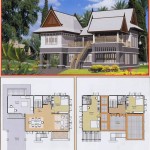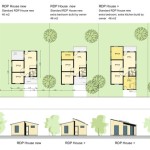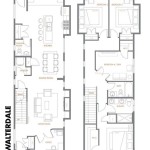The Walter Gropius House Plan: A Testament to Bauhaus Modernism
Walter Gropius, the renowned architect and founder of the Bauhaus school, designed his own house in Lincoln, Massachusetts, in 1937. This iconic home exemplifies the principles of Bauhaus architecture, characterized by its simplicity, functionality, and integration of art and design.
Principles of the House Plan
Form Follows Function: Gropius believed that the form of a building should be determined by its intended use. Accordingly, the house was designed with a rectangular plan, clear lines, and large windows to maximize light and ventilation.
Rationalism and Efficiency: The house is characterized by its rational planning and efficient use of space. The rooms are arranged in a logical sequence, and built-in storage solutions maximize space without cluttering the interiors.
Integration of Art and Architecture: Gropius emphasized the importance of integrating art and architecture. The house features custom-designed furniture, textiles, and lighting fixtures by Bauhaus artists such as Marcel Breuer and Marianne Brandt.
Architectural Features
Glass Curtain Wall: The house's most striking feature is its glass curtain wall, which extends the length of the living room and master bedroom. The wall provides a seamless connection between the interior and exterior spaces, maximizing natural light and creating a sense of openness.
Flat Roof: The Walter Gropius House features a flat roof, a common element in Bauhaus architecture. The roof appears to float above the house, creating a sense of lightness and modernity.
Floating Staircase: The floating staircase is another notable design element in the house. It appears to be suspended in mid-air, contributing to the illusion of spaciousness and lightness.
Interior Design
The interior of the Walter Gropius House is as meticulously designed as its exterior. The rooms are characterized by their simplicity, clean lines, and muted color palette. Geometric patterns and Bauhaus-inspired furnishings create a harmonious and cohesive living environment.
The house is also known for its innovative use of materials. Gropius employed steel, glass, and wood in a way that celebrates their natural textures and finishes. Natural materials, such as cypress and oak, bring warmth and a sense of organic connection to the interiors.
Legacy and Significance
The Walter Gropius House is a masterpiece of Bauhaus architecture that continues to inspire architects and designers today. It remains a testament to Gropius's belief in the power of simplicity, functionality, and the harmonious integration of art and life.
The house has been designated a National Historic Landmark and is open to the public for tours. Visitors can experience firsthand the principles of Bauhaus design and appreciate the ingenuity and foresight of one of the 20th century's most influential architects.

Gropius House In Lincoln By Walter Archeyes

Gropius House In Lincoln By Walter Archeyes

Ad Classics Gropius House Walter Plans

Spatial Relationship In Gropius House Color Representation Green Scientific Diagram

Gropius House 1st Floor Modern Plan Must Know Moderns Plans Walter

Pa3 Views Iar Gabi Petrulis

Gropius House 2d Dwg

Modern Floor Plans Gropius House

Must Know Modern Homes Gropius House

Act Image Popup








